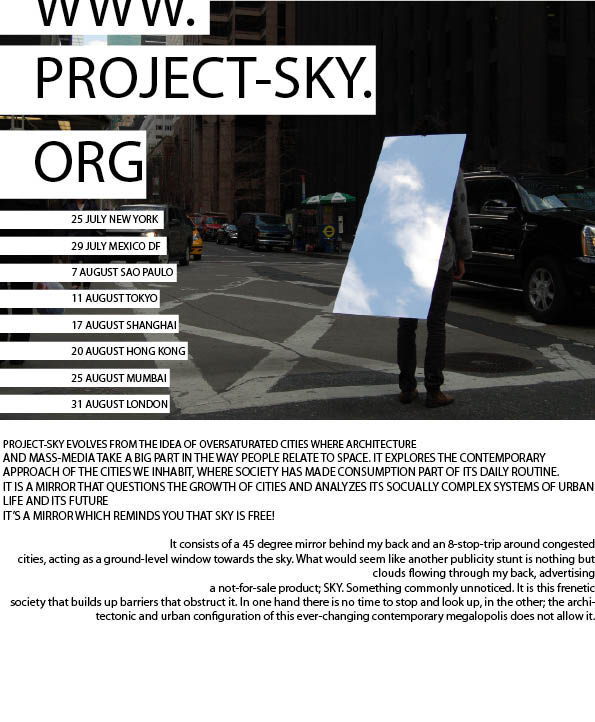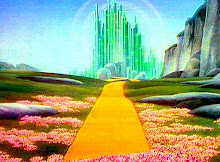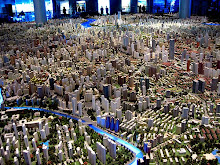

Horizontal Mexico City lead us to analyze the barrier of the second floor of the Periferico (beltway), as one of the most important conditioners of urban commuting. The advertising-less highway may even reduce the sense of an advertised landscape. As another huge spectacular, a piece of Mexican-day sky was projected over the cathedral during night, as a divine miracle! The intense Mexican little-market condition of interchanging goods made us give sky for free among the tianguis of la merced, shouting near any other seller. "CIELO GRATIS!"
SKY ECLIPSE!
Projecting day-sky at night over a 10-story building:
The first gastronomic contacts with this city remind us again of this in-order chaos we lived time ago. 20 million people living above a huge dried series of lakes, make the whole city tremble and sink.
Mexico City is located near the southern end of the plateau of Anáhuac, at an altitude of c.7,800 ft (2,380 m). The horizons of the city are almost obscured by mountain barriers, and the peaks of Popocatépetl and Iztaccihuatl are not far off. The climate is cool and dry. Much of Mexico City's surrounding valley is a lake basin with no outlet, and in the past during the rainy seasons, mountain runoff swelled the lakes.
Original and current limits of lake Texcoco under Mexico city
From the time when the Aztec capital of Tenochtitlán stood on an island in Lake Texcoco—now the heart of the metropolis—measures have been taken to protect the city and provide for expansion by draining Texcoco and the other lakes, Chalco and Xochimilco. In the 17th cent. the Spanish viceroys, notably Louis de Velasco, the younger, initiated important works. In 1900 a central canal was completed, this reached to the headwaters of the Pánuco River. The Caracol [Span. for snail], a 12-mi (19-km) spiral canal fed in turn by longitudinal canals begun in 1936, acts as an evaporating basin, from which valuable minerals are taken.
Drainage and artesian wells have lowered the water table so that the surface crust, formerly supported by subsoil water, can no longer sustain the city's heavier buildings, which are sinking some 4 to 12 in. (10.2–30 cm) a year. Some of Mexico's finest buildings have been damaged, among them the old cathedral (begun in 1553 on the site of an Aztec temple) and the Palace of Fine Arts. Modern office buildings have been shored up with pilings.
In addition to being built on soft subsoil, the city is located in a region of high seismic activity. Earthquakes in 1957 and 1985 caused substantial damage. Overcrowding has also become a major problem in Mexico City, and traffic concentrations, combined with the surrounding valley's atmospheric conditions and Popocatépetl's sulfur dioxide emissions, have resulted in heavy air pollution.
Measures have been taken to attack the pollution problem, and some progress has been made. Since 1989 automobiles have been required to stay off the roads one business day a week. The city's buses have been completely replaced, many major industries have had to convert to low-sulfur fuels, and the government closed the oil refinery.
(Columbia Encyclopedia)"Peripheral landscapes", by arquitectura911sc:
It raining cats and dogs! Performance delayed!
The mirror needed some repairs and improvements, both on the structure, which we had to have it completely welded by a plumber, and on the strapes.
Contacts with Mexican relevant thinkers are on process to arrange interviews and meetings.
Meanwhile, we decide where to give away sky by eating quesadillas, tacos, tortas, licuados,...
Three sky-phenomenons are to be explored in this amazing and rainy city:
PERIFÉRICO, TIANGUIS and ANCIENT CULTURES.
1. PERIFÉRICO (Beltway / Ring road)
skyview over the second level of the "periferico"



Ver mapa más grande
more beltways round the world:
http://www.answers.com/topic/beltway-1
2. TIANGUIS
(from náhuatl "tianquiztli") it used to mean "market" for the people from Meso-America. Currently, it is the Mexican word for the public itinerant flea market, which settles down in the middle of the city. The word inherits market traditions from pre-Hispanic civilizations, as well as the Aztecs and the Bazars from Middle East, which arrived to America through the Spanish conquerors.
The Colony of San Felipe de Jesús or Tepito in the north of Mexico city are known to host the largest informal "tianguis" of the world.







3. ANCIENT CULTURES AS SKY OBSERVERS
Dating from 200 BC to around 800 AD this 'City of the Gods' once had over 125,000 inhabitants, and was the first urban center in Meso-America. But it was abandoned in the 9th century for unknown reasons. Theories include disease or volcanic activity.
Teotihuacán as an extraordinary megalopolis of its time, an exception in Meso-America, if compared to other prehispanic ruins:
- ortogonality in its urban design. (not organic, and therefore, sacred)
- rain and human waste drainage through piping
- holy temples towards SKY, and organized by its configuration.
- domestic dwellings isolated from urban context. each unit should be self-sufficient, only keeping its connection to the sky through their patios. on the contrary, Mayan houses used to profit from open space.
According to Stansbury Hagar, the ancient Mexican city of Teotihuacán, as well as Gizeh pyramids with the Nile, were designed as a MAP of the SKY in terms of urban planning; its main Avenue, the Avenue of the Dead, would represent the Milky Way.
MEETINGS about Mexico Urban Planning and conditions of SKY with Alejandro Hernández Gálvez and Iván-Ludens.





















2 comments:
Very fine......
chicos
parece que por error
tomaron el cargador de mi ordenador
una amiga viene pronto esa es la solucion
un abrazo y mucho cielo
juan caloca
Post a Comment